9.5 – VSEPR
Bond Angles & Distances
Thus far, we have used two-dimensional Lewis structures to represent molecules. However, molecular structure is actually three-dimensional, and it is important to be able to describe molecular bonds in terms of their distances, angles, and relative arrangements in space (Figure 9.5.1). A bond angle is the angle between any two bonds that include a common atom, usually measured in degrees. A bond length (or bond distance) is the distance between the nuclei of two bonded atoms along the straight line joining the nuclei. Bond lengths are measured in Ångstroms (1 Å = 10–10 m) or picometers (1 pm = 10–12 m, 100 pm = 1 Å).

Figure 9.5.1. Bond lengths (distances) and angles are shown for the formaldehyde molecule, H2CO.
VSEPR Theory
Valence shell electron-pair repulsion theory (VSEPR theory) enables us to predict the molecular structure, including approximate bond angles around a central atom, of a molecule from an examination of the number of bonds and lone electron pairs in its Lewis structure. The VSEPR model assumes that electron pairs in the valence shell of a central atom will adopt an arrangement that minimizes repulsions between these electron pairs by maximizing the distance between them. The electrons in the valence shell of a central atom form either bonding pairs of electrons, located primarily between bonded atoms, or lone pairs. The electrostatic repulsion of these electrons is reduced when the various regions of high electron density assume positions as far from each other as possible.
VSEPR theory predicts the arrangement of electron pairs around each central atom and, usually, the correct arrangement of atoms in a molecule. We should understand, however, that the theory only considers electron-pair repulsions. Other interactions, such as nuclear-nuclear repulsions and nuclear-electron attractions, are also involved in the final arrangement that atoms adopt in a particular molecular structure.
As a simple example of VSEPR theory, let us predict the structure of a gaseous BeF2 molecule. The Lewis structure of BeF2 (Figure 9.5.2) shows only two electron pairs around the central beryllium atom. With two bonds and no lone pairs of electrons on the central atom, the bonds are as far apart as possible, and the electrostatic repulsion between these regions of high electron density is reduced to a minimum when they are on opposite sides of the central atom. The bond angle is 180° (Figure 9.5.2).

Figure 9.5.2. The BeF2 molecule adopts a linear structure in which the two bonds are as far apart as possible, on opposite sides of the Be atom.
Figure 9.5.3 illustrates this and other electron-pair geometries that minimize the repulsions among regions of high electron density (bonds and/or lone pairs). Two regions of electron density around a central atom in a molecule form a linear geometry; three regions form a trigonal planar geometry; four regions form a tetrahedral geometry; five regions form a trigonal bipyramidal geometry; and six regions form an octahedral geometry.
|
Number of regions |
Two regions of high electron density (bonds and/or unshared pairs) |
Three regions of high electron density (bonds and/or unshared pairs) |
Four regions of high electron density (bonds and/or unshared pairs) |
Five regions of high electron density (bonds and/or unshared pairs) |
Six regions of high electron density (bonds and/or unshared pairs) |
|
Spatial arrangement |
|
|
|
|
|
|
Line-dash-wedge notation |
|
|
|
|
|
|
Electron pair geometry |
Linear; 180° angle |
Trigonal planar; all angles 120° |
Tetrahedral; all angles 109.5° |
Trigonal bipyramidal; angles of 90° or 120° An attached atom may be equatorial (in the plane of the triangle) or axial (above or below the plane of the triangle) |
Octahedral; all angles 90° or 180° |
Figure 9.5.3. The basic electron-pair geometries predicted by VSEPR theory maximize the space around any region of electron density (bonds or lone pairs).
Electron-Pair Geometry versus Molecular Structure
It is important to note that electron-pair geometry around a central atom is not the same thing as its molecular structure. The electron-pair geometries shown in Figure 9.5.3 describe all regions where electrons are located, bonds as well as lone pairs. Molecular structure describes the location of the atoms, not the electrons.
We differentiate between these two situations by naming the geometry that includes all electron pairs the electron-pair geometry. The structure that includes only the placement of the atoms in the molecule is called the molecular structure. The electron-pair geometries will be the same as the molecular structures when there are no lone electron pairs around the central atom, but they will be different when there are lone pairs present on the central atom.
For example, the methane molecule, CH4, which is the major component of natural gas, has four bonding pairs of electrons around the central carbon atom; the electron-pair geometry is tetrahedral, as is the molecular structure (Figure 9.5.4). On the other hand, the ammonia molecule, NH3, also has four electron pairs associated with the nitrogen atom, and thus has a tetrahedral electron-pair geometry. One of these regions, however, is a lone pair, which is not included in the molecular structure, and this lone pair influences the shape of the molecule (Figure 9.5.5).

Figure 9.5.4. The molecular structure of the methane molecule, CH4, is shown with a tetrahedral arrangement of the hydrogen atoms. VSEPR structures like this one are often drawn using the wedge and dash notation, in which solid lines represent bonds in the plane of the page, solid wedges represent bonds coming up out of the plane, and dashed lines represent bonds going down into the plane.


Figure 9.5.5. (a) The electron-pair geometry for the ammonia molecule is tetrahedral with one lone pair and three single bonds. (b) The trigonal pyramidal molecular structure is determined from the electron-pair geometry. (c) The actual bond angles deviate slightly from the idealized angles because the lone pair takes up a larger region of space than do the single bonds, causing the HNH angle to be slightly smaller than 109.5°. (d) Lewis structure of NH3.
As seen in Figure 9.5.5, small distortions from the ideal angles in Figure 9.5.3 can result from differences in repulsion between various regions of electron density. VSEPR theory predicts these distortions by establishing an order of repulsions and an order of the amount of space occupied by different kinds of electron pairs. The order of electron-pair repulsions from greatest to least repulsion is:
lone pair-lone pair > lone pair-bonding pair > bonding pair-bonding pair
This order of repulsions determines the amount of space occupied by different regions of electrons. A lone pair of electrons occupies a larger region of space than the electrons in a triple bond; in turn, electrons in a triple bond occupy more space than those in a double bond, and so on. The order of sizes from largest to smallest is:
lone pair > triple bond > double bond > single bond
Consider formaldehyde, H2CO, which is used as a preservative for biological and anatomical specimens (Figure 9.5.1). This molecule has regions of high electron density that consist of two single bonds and one double bond. The basic geometry is trigonal planar with 120° bond angles, but we see that the double bond causes slightly larger angles (121°), and the angle between the single bonds is slightly smaller (118°).
In the ammonia molecule, the three hydrogen atoms attached to the central nitrogen are not arranged in a flat, trigonal planar molecular structure, but rather in a three-dimensional trigonal pyramid (Figure 9.5.5) with the nitrogen atom at the apex and the three hydrogen atoms forming the base. The ideal bond angles in a trigonal pyramid are based on the tetrahedral electron pair geometry. Again, there are slight deviations from the ideal because lone pairs occupy larger regions of space than do bonding electrons. The H–N–H bond angles in NH3 are slightly smaller than the 109.5° angle in a regular tetrahedron (Figure 9.5.3) because the lone pair-bonding pair repulsion is greater than the bonding pair-bonding pair repulsion (Figure 9.5.5). Figure 9.5.6 illustrates the ideal molecular structures, which are predicted based on the electron-pair geometries for various combinations of lone pairs and bonding pairs.

Figure 9.5.6. The molecular structures are identical to the electron-pair geometries when there are no lone pairs present (first column). For a particular number of electron pairs (row), the molecular structures for one or more lone pairs are determined based on modifications of the corresponding electron-pair geometry.
According to VSEPR theory, the terminal atom locations (Xs in Figure 9.5.6) are equivalent within the linear, trigonal planar, and tetrahedral electron-pair geometries (the first three rows of the table). It does not matter which X is replaced with a lone pair because the molecules can be rotated to convert positions. For trigonal bipyramidal electron-pair geometries, however, there are two distinct X positions, as shown in Figure 9.5.8: an axial position (if we hold a model of a trigonal bipyramid by the two axial positions, we have an axis around which we can rotate the model) and an equatorial position (three positions form an equator around the middle of the molecule). As shown in Figure 9.5.6, the axial position is surrounded by bond angles of 90°, whereas the equatorial position has more space available because of the 120° bond angles.

Lone pairs axial Lone pairs equatorial Lone pairs axial and equatorial
(a) (b) (c)
Interactions
90° LP-LP001
90° LP-BP643
Figure 9.5.7 Demonstration of Axial and Equatorial lone pair interactions.
In a trigonal bipyramidal electron-pair geometry, lone pairs always occupy equatorial positions because these more spacious positions can more easily accommodate the larger lone pairs.
Theoretically, we can come up with three possible arrangements for the three bonds and two lone pairs for the ClF3 molecule (Figure 9.5.8). The stable structure is the one that puts the lone pairs in equatorial locations, giving a T-shaped molecular structure.

Figure 9.5.8. (a) In a trigonal bipyramid, the two axial positions are located directly across from one another, whereas the three equatorial positions are located in a triangular arrangement. (b–d) The two lone pairs (red lines) in ClF3 have several possible arrangements, but the T-shaped molecular structure (b) is the one actually observed, consistent with the larger lone pairs both occupying equatorial positions.
When a central atom has two lone electron pairs and four bonding regions, we have an octahedral electron-pair geometry. The two lone pairs are on opposite sides of the octahedron (180° apart), giving a square planar molecular structure that minimizes lone pair-lone pair repulsions (Figure 9.5.6).
Predicting Electron Pair Geometry and Molecular Structure
The following procedure uses VSEPR theory to determine the electron pair geometries and the molecular structures:
Write the Lewis structure of the molecule or polyatomic ion.
Count the number of regions of electron density (lone pairs and bonds) around the central atom. A single, double, or triple bond counts as one region of electron density.
Identify the electron-pair geometry based on the number of regions of electron density: linear, trigonal planar, tetrahedral, trigonal bipyramidal, or octahedral (Figure 9.5.6, first column).
Use the number of lone pairs to determine the molecular structure (Figure 9.5.6). If more than one arrangement of lone pairs and chemical bonds is possible, choose the one that will minimize repulsions, remembering that lone pairs occupy more space than multiple bonds, which occupy more space than single bonds. In trigonal bipyramidal arrangements, repulsion is minimized when every lone pair is in an equatorial position. In an octahedral arrangement with two lone pairs, repulsion is minimized when the lone pairs are on opposite sides of the central atom.
The following examples illustrate the use of VSEPR theory to predict the molecular structure of molecules or ions that have no lone pairs of electrons. In this case, the molecular structure is identical to the electron pair geometry.
Example 9.5.1 – Predicting Electron-pair Geometry and Molecular Structure: CO2 and BCl3
Predict the electron-pair geometry and molecular structure for each of the following:
(a) carbon dioxide, CO2, a molecule produced by the combustion of fossil fuels
(b) boron trichloride, BCl3, an important industrial chemical
Solution
(a) We write the Lewis structure of CO2 as:

This shows us two regions of high electron density around the carbon atom—each double bond counts as one region, and there are no lone pairs on the carbon atom. Using VSEPR theory, we predict that the two regions of electron density arrange themselves on opposite sides of the central atom with a bond angle of 180°. The electron-pair geometry and molecular structure are identical, and CO2 molecules are linear.
(b) We write the Lewis structure of BCl3 as:

Thus we see that BCl3 contains three bonds, and there are no lone pairs of electrons on boron. The arrangement of three regions of high electron density gives a trigonal planar electron-pair geometry. The B–Cl bonds lie in a plane with 120° angles between them. BCl3 also has a trigonal planar molecular structure .
The electron-pair geometry and molecular structure of BCl3 are both trigonal planar. Note that the VSEPR geometry indicates the correct bond angles (120°), unlike the Lewis structure shown above.
Check Your Learning 9.5.1 – Predicting Electron-pair Geometry and Molecular Structure: CO2 and BCl3
Carbonate, CO32−, is a common polyatomic ion found in various materials from eggshells to antacids. What are the electron-pair geometry and molecular structure of this polyatomic ion?
Answer
The electron-pair geometry is trigonal planar and the molecular structure is trigonal planar. Due to resonance, all three C–O bonds are identical. Whether they are single, double, or an average of the two, each bond counts as one region of electron density.
Example 9.5.2 – Predicting Electron-pair Geometry and Molecular Structure: Ammonium
Two of the top 50 chemicals produced in the United States, ammonium nitrate and ammonium sulfate, both used as fertilizers, contain the ammonium ion. Predict the electron-pair geometry and molecular structure of the NH4+ cation.
Solution
We write the Lewis structure of NH4+ as:

We can see that NH4+ contains four bonds from the nitrogen atom to hydrogen atoms and no lone pairs. We expect the four regions of high electron density to arrange themselves so that they point to the corners of a tetrahedron with the central nitrogen atom in the middle (Figure 9.5.6). Therefore, the electron pair geometry of NH4+ is tetrahedral, and the molecular structure is also tetrahedral: (Figure 9.5.9).
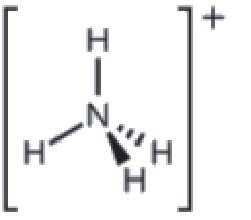
Figure 9.5.9. The ammonium ion displays a tetrahedral electron-pair geometry as well as a tetrahedral molecular structure.
Check Your Learning 9.5.2 – Predicting Electron-pair Geometry and Molecular Structure: Ammonium
Identify a molecule with trigonal bipyramidal molecular structure.
Answer
Any molecule with five electron pairs around the central atoms including no lone pairs will be trigonal bipyramidal. PF5 is a common example.
The next several examples illustrate the effect of lone pairs of electrons on molecular structure.
Example 9.5.3 – Predicting Electron-pair Geometry and Molecular Structure: Lone Pairs on the Central Atom
Predict the electron-pair geometry and molecular structure of a water molecule.
Solution
The Lewis structure of H2O indicates that there are four regions of high electron density around the oxygen atom: two lone pairs and two chemical bonds:
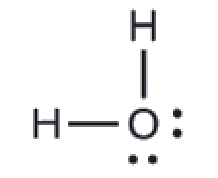
We predict that these four regions are arranged in a tetrahedral fashion (Figure 9.5.10), as indicated in Figure 9.5.6. Thus, the electron-pair geometry is tetrahedral and the molecular structure is bent with an angle slightly less than 109.5°. In fact, the bond angle is 104.5°.

Figure 9.5.10. (a) H2O has four regions of electron density around the central atom (Two atoms and 2 electron pairs), so it has a tetrahedral electron-pair geometry. Two of the electron regions are lone pairs, so the molecular structure is bent.
Check Your Learning 9.5.3 – Predicting Electron-pair Geometry and Molecular Structure: Lone Pairs on the Central Atom
The hydronium ion, H3O+, forms when acids are dissolved in water. Predict the electron-pair geometry and molecular structure of this cation.
Answer
electron pair geometry: tetrahedral; molecular structure: trigonal pyramidal
Example 9.5.4 – Predicting Electron-pair Geometry and Molecular Structure: SF4
Sulfur tetrafluoride, SF4, is extremely valuable for the preparation of fluorine-containing compounds used as herbicides (i.e., SF4 is used as a fluorinating agent). Predict the electron-pair geometry and molecular structure of a SF4 molecule.
Solution
The Lewis structure of SF4 indicates five regions of electron density around the sulfur atom: one lone pair and four bonding pairs:
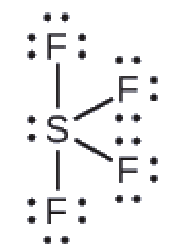
We expect these five regions to adopt a trigonal bipyramidal electron-pair geometry. To minimize lone pair repulsions, the lone pair occupies one of the equatorial positions. The molecular structure (Figure 9.5.11) is that of a seesaw (Figure 9.5.6).
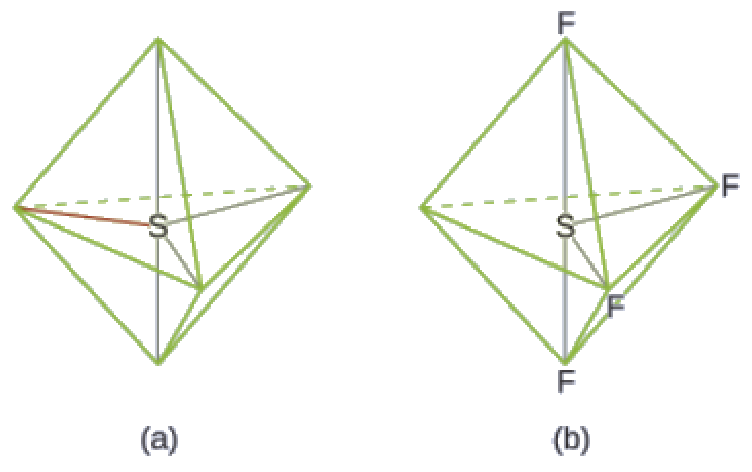
Figure 9.5.11. (a) SF4 has a trigonal bipyramidal arrangement of the five regions of electron density. (b) One of the regions is a lone pair, which results in a seesaw-shaped molecular structure.
Check Your Learning 9.5.4 – Predicting Electron-pair Geometry and Molecular Structure: SF4
Predict the electron pair geometry and molecular structure for molecules of XeF2.
Answer
The electron-pair geometry is trigonal bipyramidal. The molecular structure is linear.
Example 9.5.5 – Predicting Electron-pair Geometry and Molecular Structure: XeF4
Of all the noble gases, xenon is the most reactive, frequently reacting with elements such as oxygen and fluorine. Predict the electron-pair geometry and molecular structure of the XeF4 molecule.
Solution
The Lewis structure of XeF4 indicates six regions of high electron density around the xenon atom: two lone pairs and four bonds:
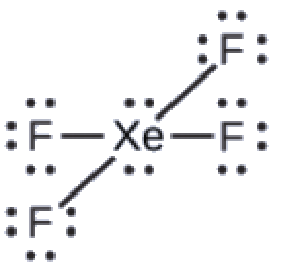
These six regions adopt an octahedral arrangement (Figure 9.5.6), which is the electron-pair geometry. To minimize repulsions, the lone pairs should be on opposite sides of the central atom (Figure 9.5.12). The five atoms are all in the same plane and have a square planar molecular structure.

Figure 9.5.12. (a) XeF4 adopts an octahedral arrangement with two lone pairs (red lines) and four bonds in the electron-pair geometry. (b) The molecular structure is square planar with the lone pairs directly across from one another.
Check Your Learning 9.5.5 – Predicting Electron-pair Geometry and Molecular Structure: XeF4
In a certain molecule, the central atom has three lone pairs and two bonds. What will the electron pair geometry and molecular structure be?
Answer
electron pair geometry: trigonal bipyramidal; molecular structure: linear
Example 9.5.6 – Predicting Molecular Structure – VSEPR Summary
Using the VSEPR model, predict the molecular geometry of each molecule or ion.
(a) PF5 (phosphorus pentafluoride, a catalyst used in certain organic reactions)
(b) H3O+ (hydronium ion)
Solution
(a) The central atom, P, has five valence electrons and each fluorine has seven valence electrons, so the Lewis structure of PF5 is

There are five bonding groups about phosphorus. The structure that minimizes repulsions is a trigonal bipyramid.
All electron groups are bonding pairs, so PF5 is designated as AX5. Notice that this gives a total of five electron pairs. With no lone pair repulsions, we do not expect any bond angles to deviate from the ideal.
The PF5 molecule has five nuclei and no lone pairs of electrons, so its molecular geometry is trigonal bipyramidal.

(b) The central atom, O, has six valence electrons, and each H atom contributes one valence electron. Subtracting one electron for the positive charge gives a total of eight valence electrons, so the Lewis electron structure is
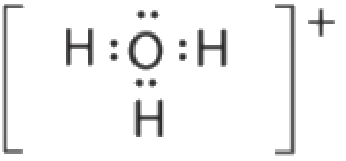
There are four electron groups around oxygen, three bonding pairs and one lone pair. Like NH3, repulsions are minimized by directing each hydrogen atom and the lone pair to the corners of a tetrahedron.
With three bonding pairs and one lone pair, we expect the interactions between lone (nonbonding) and bonding pairs of electrons to cause the bonding pair angles to deviate significantly from the angles of a perfect tetrahedron.
There are three nuclei and one lone pair, so the molecular geometry is trigonal pyramidal, in essence a tetrahedron missing a vertex. However, the H–O–H bond angles are less than the ideal angle of 109.5° because of repulsions between the lone pair (nonbonding) and bonding pairs of electrons:
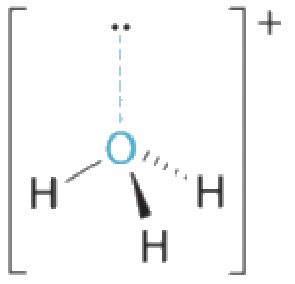
Check Your Learning 9.5.6 – Predicting Molecular Structure – VSEPR Summary
Using the VSEPR model, predict the molecular geometry of each molecule or ion.
(a) XeO3
(b) PF6−
(c) NO2+
Answer
(a) trigonal pyramidal; (b) octahedral; (c) linear
Molecular Structure for Multicenter Molecules
When a molecule or polyatomic ion has only one central atom, the molecular structure completely describes the shape of the molecule. Larger molecules do not have a single central atom, but are connected by a chain of interior atoms that each possess a “local” geometry. The way these local structures are oriented with respect to each other also influences the molecular shape, but such considerations are largely beyond the scope of this introductory discussion. For our purposes, we will only focus on determining the local structures.
Example 9.5.7 – Predicting Structure in Multicenter Molecules
The Lewis structure for the simplest amino acid, glycine, H2NCH2CO2H, is shown here. Predict the local geometry for the nitrogen atom, the two carbon atoms, and the oxygen atom with a hydrogen atom attached:
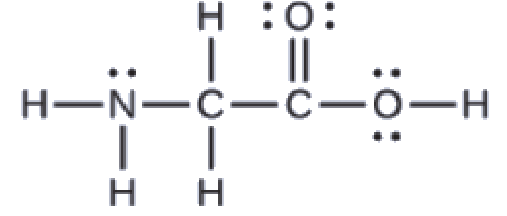
Solution
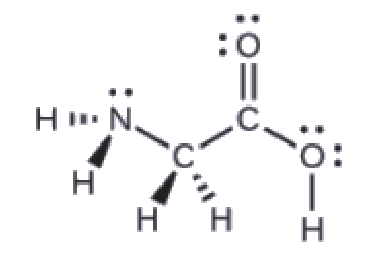
Consider each central atom independently. The electron-pair geometries:
nitrogen––four regions of electron density; tetrahedral
carbon (CH2)––four regions of electron density; tetrahedral
carbon (CO2)—three regions of electron density; trigonal planar
oxygen (OH)—four regions of electron density; tetrahedral
The local structures:
nitrogen––three bonds, one lone pair; trigonal pyramidal
carbon (CH2)—four bonds, no lone pairs; tetrahedral
carbon (CO2)—three bonds (double bond counts as one bond), no lone pairs; trigonal planar
oxygen (OH)—two bonds, two lone pairs; bent (109°)
Check Your Learning 9.5.7 – Predicting Structure in Multicenter Molecules
Another amino acid is alanine, which has the Lewis structure shown here. Predict the electron-pair geometry and local structure of the nitrogen atom, the three carbon atoms, and the oxygen atom with hydrogen attached:
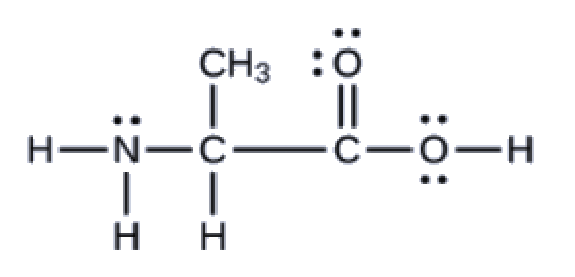
Answer
electron-pair geometries: nitrogen––tetrahedral; carbon (CH)—tetrahedral; carbon (CH3)—tetrahedral; carbon (CO2)—trigonal planar; oxygen (OH)—tetrahedral; local structures: nitrogen—trigonal pyramidal; carbon (CH)—tetrahedral; carbon (CH3)—tetrahedral; carbon (CO2)—trigonal planar; oxygen (OH)—bent (109°)
|
VSEPR – Interactive Activity |
|
This molecular shape simulator from PhET lets you build various molecules and practice naming their electron-pair geometries and molecular structures. |
Molecular Polarity and Dipole Moment
As discussed previously, polar covalent bonds connect two atoms with differing electronegativities, leaving one atom with a partial positive charge (δ+) and the other atom with a partial negative charge (δ–), as the electrons are pulled toward the more electronegative atom. This separation of charge gives rise to a bond dipole moment. The magnitude of a bond dipole moment is represented by the Greek letter mu (µ) and is given by the formula shown here, where Q is the magnitude of the partial charges (determined by the electronegativity difference) and r is the distance between the charges:
μ = Qr
This bond moment can be represented as a vector, a quantity having both direction and magnitude (Figure 9.5.13). Dipole vectors are shown as arrows pointing along the bond from the less electronegative atom toward the more electronegative atom. A small plus sign is drawn on the less electronegative end to indicate the partially positive end of the bond. The length of the arrow is proportional to the magnitude of the electronegativity difference between the two atoms.

Figure 9.5.13. (a) There is a small difference in electronegativity between C and H, represented as a short vector. (b) The electronegativity difference between B and F is much larger, so the vector representing the bond moment is much longer.
A whole molecule may also have a separation of charge, depending on its molecular structure and the polarity of each of its bonds. If such a charge separation exists, the molecule is said to be a polar molecule (or dipole); otherwise the molecule is said to be nonpolar. The dipole moment measures the extent of net charge separation in the molecule as a whole. We determine the dipole moment by adding the bond moments in three-dimensional space, taking into account the molecular structure.
For diatomic molecules, there is only one bond, so its bond dipole moment determines the molecular polarity. Homonuclear diatomic molecules such as Br2 and N2 have no difference in electronegativity, so their dipole moment is zero. For heteronuclear molecules such as CO, there is a small dipole moment. For HF, there is a larger dipole moment because there is a larger difference in electronegativity.
When a molecule contains more than one bond, the geometry must be taken into account. If the bonds in a molecule are arranged such that their bond moments cancel (vector sum equals zero), then the molecule is nonpolar. This is the situation in CO2 (Figure 9.5.14). Each of the bonds is polar, but the molecule as a whole is nonpolar. From the Lewis structure, and using VSEPR theory, we determine that the CO2 molecule is linear with polar C=O bonds on opposite sides of the carbon atom. The bond moments cancel because they are pointed in opposite directions. In the case of the water molecule (Figure 9.5.14), the Lewis structure again shows that there are two bonds to a central atom, and the electronegativity difference again shows that each of these bonds has a nonzero bond moment. In this case, however, the molecular structure is bent because of the lone pairs on O, and the two bond moments do not cancel. Therefore, water does have a net dipole moment and is a polar molecule (dipole).
Figure 9.5.14. The overall dipole moment of a molecule depends on the individual bond dipole moments and how they are arranged. (a) Each CO bond has a bond dipole moment, but they point in opposite directions so that the net CO2 molecule is nonpolar. (b) In contrast, water is polar because the OH bond moments do not cancel out.
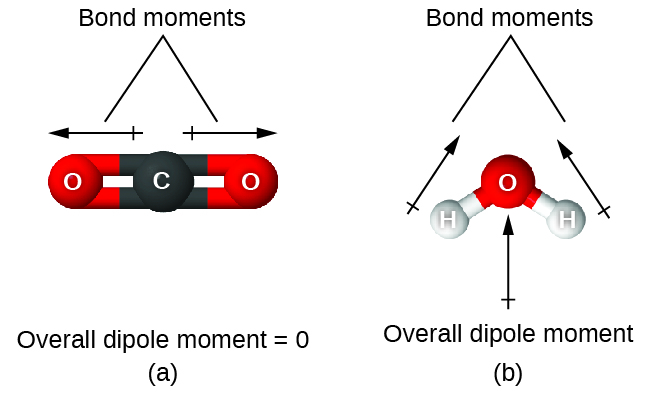
The OCS molecule has a structure similar to CO2, but a sulfur atom has replaced one of the oxygen atoms. To determine if this molecule is polar, we draw the molecular structure. VSEPR theory predicts a linear molecule:
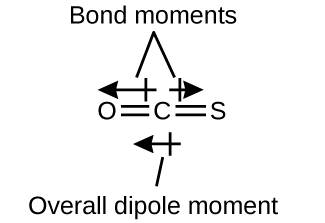
The C-O bond is considerably polar. Although C and S have very similar electronegativity values, S is slightly more electronegative than C, and so the C-S bond is just slightly polar. Because oxygen is more electronegative than sulfur, the oxygen end of the molecule is the negative end.
Chloromethane, CH3Cl, is another example of a polar molecule. Although the polar C–Cl and C–H bonds are arranged in a tetrahedral geometry, the C–Cl bonds have a larger bond moment than the C–H bond, and the bond moments do not completely cancel each other. All of the dipoles have an upward component in the orientation shown, since carbon is more electronegative than hydrogen and less electronegative than chlorine:
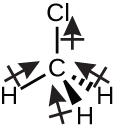
When we examine the highly symmetrical molecules BF3 (trigonal planar), CH4 (tetrahedral), PF5 (trigonal bipyramidal), and SF6 (octahedral), in which all the polar bonds are identical, the molecules are nonpolar. The bonds in these molecules are arranged such that their dipoles cancel. However, just because a molecule contains identical bonds does not mean that the dipoles will always cancel. Many molecules that have identical bonds and lone pairs on the central atoms have bond dipoles that do not cancel. Examples include H2S and NH3. A hydrogen atom is at the positive end and a nitrogen or sulfur atom is at the negative end of the polar bonds in these molecules:

To summarize, to be polar, a molecule must:
Contain at least one polar covalent bond.
Have a molecular structure such that the sum of the vectors of each bond dipole moment does not cancel.
Properties of Polar Molecules
Polar molecules tend to align when placed in an electric field with the positive end of the molecule oriented toward the negative plate and the negative end toward the positive plate (Figure 9.5.15). We can use an electrically charged object to attract polar molecules, but nonpolar molecules are not attracted. Also, polar solvents are better at dissolving polar substances, and nonpolar solvents are better at dissolving nonpolar substances.
Figure 9.5.15. (a) Molecules are always randomly distributed in the liquid state in the absence of an electric field. (b) When an electric field is applied, polar molecules like HF will align to the dipoles with the field direction.
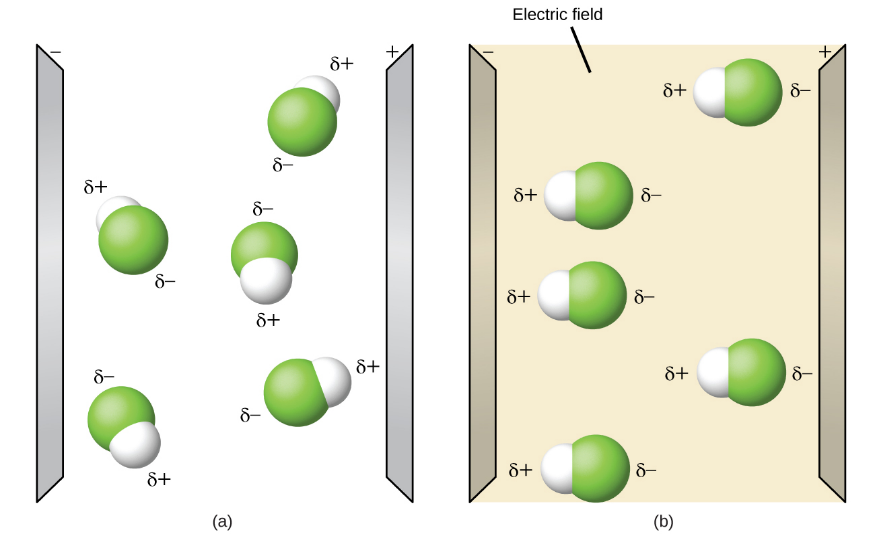
|
Molecular Polarity – Interactive Activity |
|
This molecule polarity simulation from PhET provides many ways to explore dipole moments of bonds and molecules. |
★ Questions
1. Explain why the HOH molecule is bent, whereas the HBeH molecule is linear.
2. Explain the difference between electron-pair geometry and molecular structure.
3. Explain how a molecule that contains polar bonds can be nonpolar.
4. Predict the electron pair geometry and the molecular structure of each of the following molecules or ions:
a) SF6
b) PCl5
c) BeH2
d) CH3+
5. What are the electron-pair geometry and the molecular structure of each of the following molecules or ions?
a) ClF5
b) ClO2−
c) TeCl42−
d) PCl3
e) SeF4
f) PH2−
6. Identify the electron pair geometry and the molecular structure of each of the following molecules:
a) ClNO (N is the central atom)
b) CS2
c) Cl2CO (C is the central atom)
d) Cl2SO (S is the central atom)
e) SO2F2 (S is the central atom)
f) XeO2F2 (Xe is the central atom)
g) ClOF2+ (Cl is the central atom)
7. Which of the following molecules and ions contain polar bonds? Which of these molecules and ions have dipole moments?
a) ClF5
b) ClO2−
c) TeCl42−
d) PCl3
e) SeF4
f) PH2−
g) XeF2
8. Which of the following molecules have dipole moments?
a) CS2
b) SeS2
c) CCl2F2
d) PCl3 (P is the central atom)
e) ClNO (N is the central atom)
9. The molecule XF3 has a dipole moment. Is X boron or phosphorus?
10. Is the Cl2BBCl2 molecule polar or nonpolar?
11. Describe the molecular structure around the indicated atom or atoms:
a) The sulfur atom in sulfuric acid, H2SO4 [(HO)2SO2]
b) The chlorine atom in chloric acid, HClO3 [HOClO2]
c) The oxygen atom in hydrogen peroxide, HOOH
d) The nitrogen atom in nitric acid, HNO3 [HONO2]
e) The oxygen atom in the OH group in nitric acid, HNO3 [HONO2]
f) The central oxygen atom in the ozone molecule, O3
g) Each of the carbon atoms in propyne, CH3CCH
h) The carbon atom in Freon, CCl2F2
i) Each of the carbon atoms in allene, H2CCCH2
★★ Questions
12. A molecule with the formula AB2, in which A and B represent different atoms, could have one of three different shapes. Sketch and name the three different shapes that this molecule might have. Give an example of a molecule or ion for each shape.
Answers
1. The placement of the two sets of unpaired electrons in water forces the bonds to assume a tetrahedral arrangement, and the resulting HOH molecule is bent. The HBeH molecule (in which Be has only two electrons to bond with the two electrons from the hydrogens) must have the electron pairs as far from one another as possible and is therefore linear.
2. Space must be provided for each pair of electrons whether they are in a bond or are present as lone pairs. Electron-pair geometry considers the placement of all electrons. Molecular structure considers only the bonding-pair geometry.
3. As long as the polar bonds are compensated (for example. two identical atoms are found directly across the central atom from one another), the molecule can be nonpolar.
4.
a) Both the electron geometry and the molecular structure are octahedral.
b) Both the electron geometry and the molecular structure are trigonal bipyramid.
c) Both the electron geometry and the molecular structure are linear.
d) Both the electron geometry and the molecular structure are trigonal planar.
5.
a) electron-pair geometry: octahedral, molecular structure: square pyramidal;
b) electron-pair geometry: tetrahedral, molecular structure: bent;
c) electron-pair geometry: octahedral, molecular structure: square planar;
d) electron-pair geometry: tetrahedral, molecular structure: trigonal pyramidal;
e) electron-pair geometry: trigonal bipyramidal, molecular structure: seesaw;
f) electron-pair geometry: tetrahedral, molecular structure: bent (109°)
6.
a) electron-pair geometry: trigonal planar, molecular structure: bent (120°);
b) electron-pair geometry: linear, molecular structure: linear;
c) electron-pair geometry: trigonal planar, molecular structure: trigonal planar;
d) electron-pair geometry: tetrahedral, molecular structure: trigonal pyramidal;
e) electron-pair geometry: tetrahedral, molecular structure: tetrahedral;
f) electron-pair geometry: trigonal bipyramidal, molecular structure: seesaw;
g) electron-pair geometry: tetrahedral, molecular structure: trigonal pyramidal
7. All of these molecules and ions contain polar bonds. Only ClF5, ClO2−, PCl3, SeF4, and PH2− have dipole moments.
8. SeS2, CCl2F2, PCl3, and ClNO all have dipole moments.
9. P
10. Nonpolar
11. (a) tetrahedral; (b) trigonal pyramidal; (c) bent (109°); (d) trigonal planar; (e) bent (109°); (f) bent (109°); (g) CH3CCH tetrahedral, CH3CCH linear; (h) tetrahedral; (i) H2CCCH2 linear; H2CCCH2 trigonal planar
12.
a) CO2, linear

b) H2O, bent with an approximately 109° angle
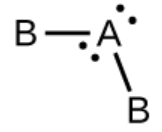
c) SO2, bent with an approximately 120° angle
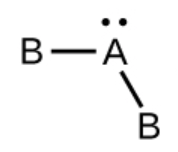
Angle between any two covalent bonds that share a common atom
Distance between the nuclei of two bonded atoms at which the lowest potential energy is achieved
Distance between the nuclei of two bonded atoms at which the lowest potential energy is achieved
Theory used to predict the bond angles in a molecule based on positioning regions of high electron density as far apart as possible to minimize electrostatic repulsion
Shape in which two outside groups are placed on opposite sides of a central atom
Shape in which three outside groups are placed in a flat triangle around a central atom with 120° angles between each pair and the central atom
Shape in which four outside groups are placed around a central atom such that a three-dimensional shape is generated with four corners and 109.5° angles between each pair and the central atom
Shape in which five outside groups are placed around a central atom such that three form a flat triangle with 120° angles between each pair and the central atom, and the other two form the apex of two pyramids, one above and one below the triangular plane
Shape in which six outside groups are placed around a central atom such that a three-dimensional shape is generated with four groups forming a square and the other two forming the apex of two pyramids, one above and one below the square plane
Arrangement around a central atom of all regions of electron density (bonds, lone pairs, or unpaired electrons)
Arrangement of atoms in a molecule or ion; in VSEPR theory, it refers to a structure that includes only the placement of the atoms in the molecule
Location in a trigonal bipyramidal geometry in which there is another atom at a 180° angle and the equatorial positions are at a 90° angle
One of the three positions in a trigonal bipyramidal geometry with 120° angles between them; the axial positions are located at a 90° angle
Separation of charge in a bond that depends on the difference in electronegativity and the bond distance represented by partial charges or a vector
Quantity having magnitude and direction
Molecule with an overall dipole moment
Molecule with an overall dipole moment
Property of a molecule that describes the separation of charge determined by the sum of the individual bond moments based on the molecular structure











